The Mausoleum of the First Qin Emperor, Qin Shi Huang is the largest preserved one in China. It is a unique architectural ensemble whose layout echoes the urban plan of the capital, Xianyang, with the Imperial Palace enclosed by the walls of the city, themselves encircled by other walls. The mausoleum is also associated with an event of universal significance: the first unification of the Chinese territory in a centralized state created by an absolute monarch, in 221 BC.
Qin Shi Huang is a pivotal figure in Chinese history. After unifying China, he and his chief advisor Li Si passed a series of major economic and political reforms. He undertook gigantic projects, including the first version of the Great Wall of China, the now famous city-sized mausoleum guarded by a life-sized Terracotta Army, and a massive national road system, all at the expense of numerous lives. To ensure stability, Qin Shi Huang outlawed and burned many books.
 The first Emperor of China, Qin Shi Huang (Ying Zheng: 221-210 BC) arranged for his burial place long before his accession to the seat of supreme power. When he became king of Qin in 247 BC, Zheng had his geomancers choose a favourable site at the foot of Mount Li. Work was commenced and was carried out more energetically with each new political and military success over his rivals Han, Zhao, Wei, Chu, Yan and Qi. Following the proclamation of the Empire of Ten Thousand Generations in 221, work at the burial place took on extraordinary dimensions.
The first Emperor of China, Qin Shi Huang (Ying Zheng: 221-210 BC) arranged for his burial place long before his accession to the seat of supreme power. When he became king of Qin in 247 BC, Zheng had his geomancers choose a favourable site at the foot of Mount Li. Work was commenced and was carried out more energetically with each new political and military success over his rivals Han, Zhao, Wei, Chu, Yan and Qi. Following the proclamation of the Empire of Ten Thousand Generations in 221, work at the burial place took on extraordinary dimensions. After Qin Shi Huang's death, the principal craftsmen of the hypogeum were walled up on the orders of the second emperor, as a precaution against their betraying their secrets. The mausoleum, 35 km from Xian, is still landmarked by an imposing mound 43 m high. The interior is built within a first square enclosure, with doors in the middle of each of the four walls corresponding to the four cardinal points. This in turn is surrounded by a second rectangular enclosure running north-south.
After Qin Shi Huang's death, the principal craftsmen of the hypogeum were walled up on the orders of the second emperor, as a precaution against their betraying their secrets. The mausoleum, 35 km from Xian, is still landmarked by an imposing mound 43 m high. The interior is built within a first square enclosure, with doors in the middle of each of the four walls corresponding to the four cardinal points. This in turn is surrounded by a second rectangular enclosure running north-south.The mausoleum's superstructures have disappeared and there remains only a wooded knoll resembling a truncated pyramid on a 350 m square base. While sinking a well 1.5 km from the exterior eastern wall of the mausoleum's inner room, three peasants from the small village of Yangeun-West came upon a pit in which there were lifesize terracotta statues of warriors. Excavations were begun immediately.
The Terracotta Army (traditional Chinese; pinyin: bingma yong; literally "soldier and horse funerary statues") or the "Terra Cotta Warriors and Horses", is a collection of terracotta sculptures depicting the armies of Qin Shi Huang, the First Emperor of China. The figures, dating from 210 BC, were discovered in 1974 by some local farmers near Xi'an, Shaanxi province, China near the Mausoleum of the First Qin Emperor (Chinese; pinyin: Qin Shihuang Ling).
The figures vary in height 1.83–1.95 metres (6.0–6.4 ft), according to their roles, with the tallest being the generals. The figures include warriors, chariots, horses, officials, acrobats, strongmen and musicians. Current estimates are that in the three pits containing the Terracotta Army there were over 8,000 soldiers, 130 chariots with 520 horses and 150 cavalry horses, the majority of which are still buried in the pits.
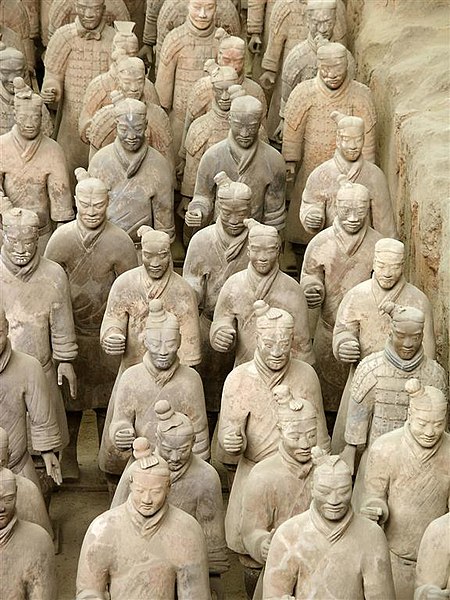 The Terracotta Army was discovered in the spring of 1974 in the eastern suburbs of Xi'an, Shaanxi Province by a group of farmers who were digging a water well 1.5 miles (2.4 km) east of Mount Li. The region around the mountain was riddled with underground springs and watercourses. In 195 B.C., Liu Bang himself — the first emperor of the dynasty that followed the Qin — had ordered that 'twenty households' should move to the site of the mausoleum of the First Emperor of Qin (Qin Shi Huang, "shi huang" means the first emperor) to watch over the tomb. To this day, twenty villages sit in the immediate vicinity of the mausoleum, one of them the hamlet where the Yang family lived; the terracotta army may have been rediscovered by the direct descendants of the people left to guard it. For centuries, there were reports of pieces of terracotta figures and fragments of the Qin necropolis — roofing tiles, bricks, and chunks of masonry — having been occasionally dug up in the area.
The Terracotta Army was discovered in the spring of 1974 in the eastern suburbs of Xi'an, Shaanxi Province by a group of farmers who were digging a water well 1.5 miles (2.4 km) east of Mount Li. The region around the mountain was riddled with underground springs and watercourses. In 195 B.C., Liu Bang himself — the first emperor of the dynasty that followed the Qin — had ordered that 'twenty households' should move to the site of the mausoleum of the First Emperor of Qin (Qin Shi Huang, "shi huang" means the first emperor) to watch over the tomb. To this day, twenty villages sit in the immediate vicinity of the mausoleum, one of them the hamlet where the Yang family lived; the terracotta army may have been rediscovered by the direct descendants of the people left to guard it. For centuries, there were reports of pieces of terracotta figures and fragments of the Qin necropolis — roofing tiles, bricks, and chunks of masonry — having been occasionally dug up in the area.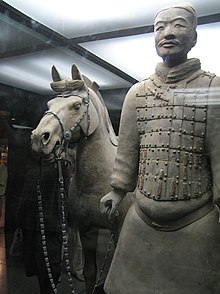 This most recent discovery prompted archaeologists to investigate. The Terracotta Army is a form of funerary art buried with the First Emperor of Qin in 210-209 BC. The Army's purpose was to help rule another empire with Qin Shi Huang in the afterlife. Consequently, they are also sometimes referred to as "Qin's Armies." The material to make the terracotta warriors originated on Mount Lishan. In addition to the warriors, an entire man-made necropolis for the emperor has been excavated. Up to 5 metres (16 feet) of reddish, sandy soil had accumulated over the site in the centuries following its construction, but archaeologists also found evidence of earlier, impromptu discoveries. During the digs at Mount Li, archaeologists found several graves from the eighteenth and nineteenth centuries, whose diggers had obviously struck terracotta fragments, only to discard them as worthless with the rest of the back-filled soil.
This most recent discovery prompted archaeologists to investigate. The Terracotta Army is a form of funerary art buried with the First Emperor of Qin in 210-209 BC. The Army's purpose was to help rule another empire with Qin Shi Huang in the afterlife. Consequently, they are also sometimes referred to as "Qin's Armies." The material to make the terracotta warriors originated on Mount Lishan. In addition to the warriors, an entire man-made necropolis for the emperor has been excavated. Up to 5 metres (16 feet) of reddish, sandy soil had accumulated over the site in the centuries following its construction, but archaeologists also found evidence of earlier, impromptu discoveries. During the digs at Mount Li, archaeologists found several graves from the eighteenth and nineteenth centuries, whose diggers had obviously struck terracotta fragments, only to discard them as worthless with the rest of the back-filled soil.Qin Shi Huang’s necropolis complex was constructed to serve as an imperial compound or palace. It comprises several offices, halls and other structures and is surrounded by a wall with gateway entrances. It was also said as a legend that the terracotta warriors were real soldiers, buried with Emperor Qin so that they could defend him from any dangers in the next life.
Construction
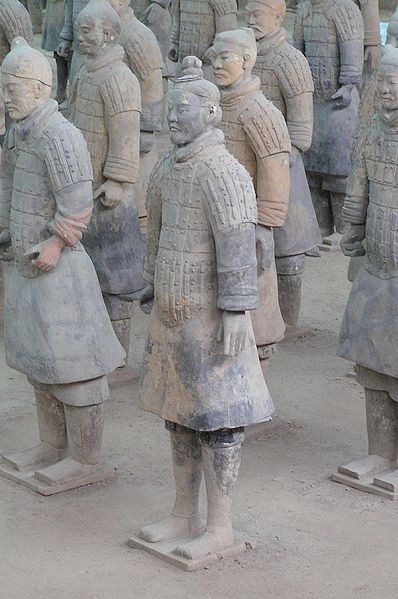 The terracotta army figures were manufactured in workshops by government laborers and by local craftsmen. The head, arms, legs and torsos were created separately and then assembled. Studies show that eight face moulds were most likely used, and then clay was added to provide individual facial features. Once assembled, intricate features such as facial expressions were added. It is believed that their legs were made in much the same way that terracotta drainage pipes were manufactured at the time. This would make it an assembly line production, with specific parts manufactured and assembled after being fired, as opposed to crafting one solid piece and subsequently firing it. In those times of tight imperial control, each workshop was required to inscribe its name on items produced to ensure quality control. This has aided modern historians in verifying that workshops that once made tiles and other mundane items were commandeered to work on the terracotta army. Upon completion, the terracotta figures were placed in the pits in precise military formation according to rank and duty.
The terracotta army figures were manufactured in workshops by government laborers and by local craftsmen. The head, arms, legs and torsos were created separately and then assembled. Studies show that eight face moulds were most likely used, and then clay was added to provide individual facial features. Once assembled, intricate features such as facial expressions were added. It is believed that their legs were made in much the same way that terracotta drainage pipes were manufactured at the time. This would make it an assembly line production, with specific parts manufactured and assembled after being fired, as opposed to crafting one solid piece and subsequently firing it. In those times of tight imperial control, each workshop was required to inscribe its name on items produced to ensure quality control. This has aided modern historians in verifying that workshops that once made tiles and other mundane items were commandeered to work on the terracotta army. Upon completion, the terracotta figures were placed in the pits in precise military formation according to rank and duty.The terracotta figures are life-like and life-sized. They vary in height, uniform and hairstyle in accordance with rank. The coloured lacquer finish, individual facial features, and actual weapons and armor from battle used in manufacturing these figures created a realistic appearance. The original weapons were stolen by robbers shortly after the creation of the army and the colouring has faded greatly. However, their existence serves as a testament to the amount of labor and skill involved in their construction. It also reveals the power the First Emperor possessed, enabling him to command such a monumental undertaking.
Pits: The four pits associated with the dig are about 1.5 km east of the burial ground and are about 7 metres deep. The outside walls of the tomb complex are as if placed there to protect the tomb from the east, where all the conquered states lay. They are solidly built with rammed earth walls and ground layers as hard as concrete. In addition to delineating the site, these served to protect the ground beneath the site from springs in the area, as also mentioned in the Shiji. Pit one, 230 metres long, contains the main army, estimated at 8,000 figures. Pit one has 11 corridors, most of which are over 3 metres wide, and paved with small bricks with a wooden ceiling supported by large beams and posts.
 This design was also used for the tombs of noblemen and would have resembled palace hallways. The wooden ceilings were covered with reed mats and layers of clay for waterproofing, and then mounded with more soil making them, when built, about 2 to 3 metres higher than ground level. Pit two has cavalry and infantry units as well as war chariots and is thought to represent a military guard. Pit three is the command post, with high ranking officers and a war chariot. Pit four is empty, seemingly left unfinished by its builders.
This design was also used for the tombs of noblemen and would have resembled palace hallways. The wooden ceilings were covered with reed mats and layers of clay for waterproofing, and then mounded with more soil making them, when built, about 2 to 3 metres higher than ground level. Pit two has cavalry and infantry units as well as war chariots and is thought to represent a military guard. Pit three is the command post, with high ranking officers and a war chariot. Pit four is empty, seemingly left unfinished by its builders.According to current estimates, the statue army of the Qin Shi Huang Mausoleum must have represented the exact number of the imperial guards. Over the past thirteen years, discoveries have revealed the dimensions of the mausoleum, and the site constitutes one of the most fabulous archaeological reserves in the world.
Because of their exceptional technical and artistic qualities, the terracotta warriors and horses and the funerary carts in bronze are major works in the history of Chinese sculpture prior to the reign of the Han dynasty. The army of statues also bears unique testimony to the military organization in China at the time of the Warring Kingdoms (475-221 BC) and that of the short-lived Empire of a Thousand Generations (221-210 BC). The direct testimony of the objects found in situ (lances, swords, axes, halberds, bows, arrows, etc.) is evident.
Images: http://commons.wikimedia.org/wiki/Category:Terracotta_Army
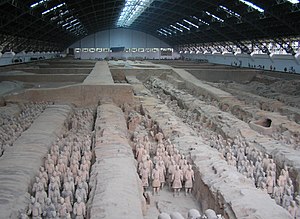
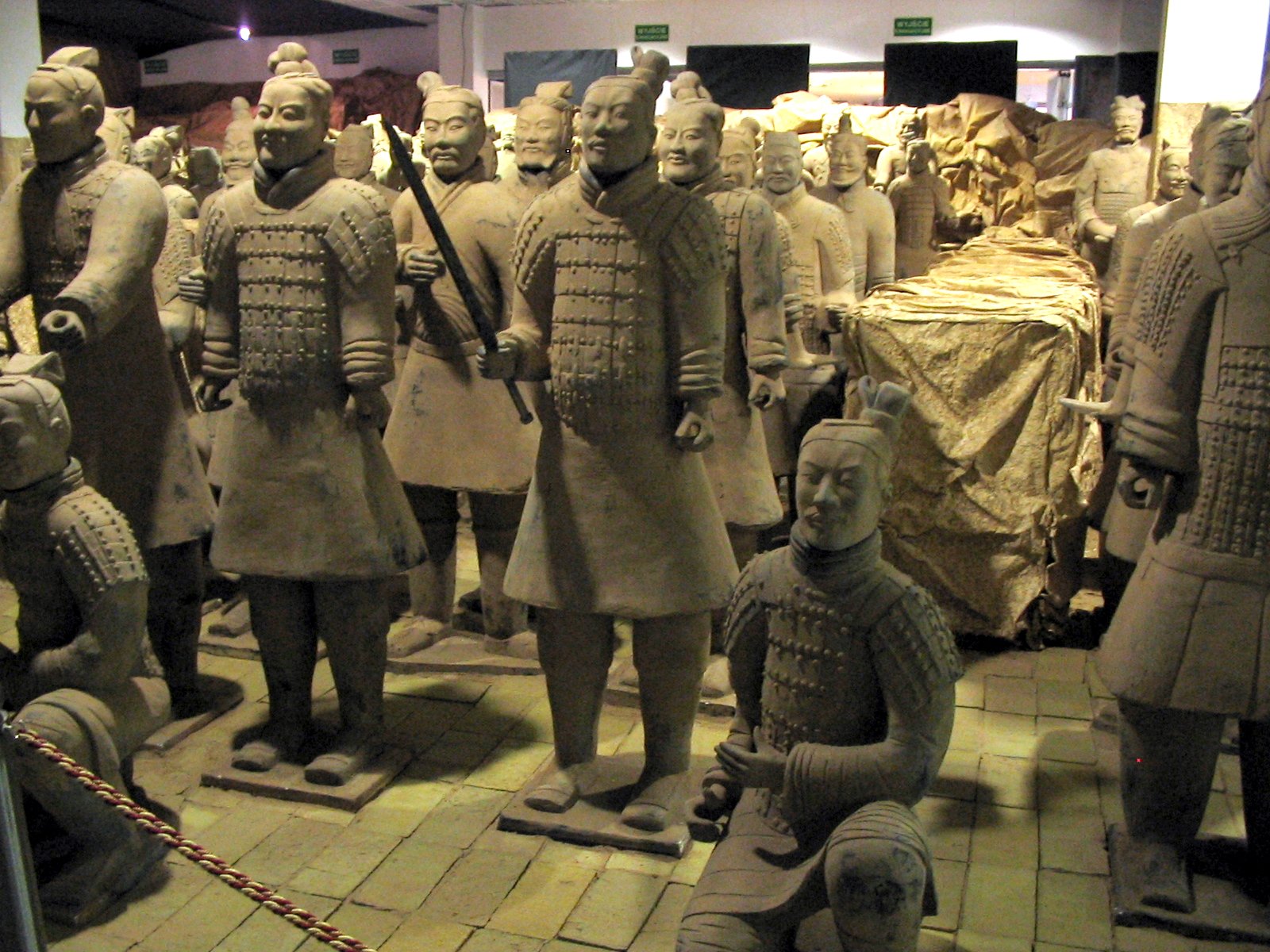











1 comments:
Post a Comment